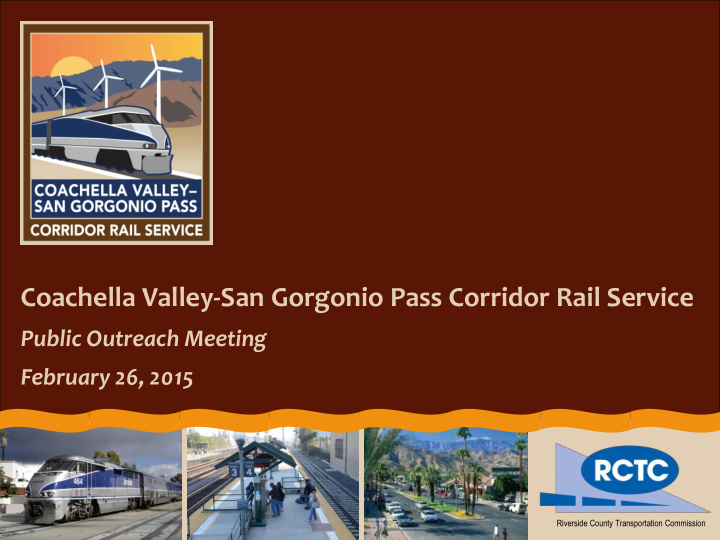



Coachella Valley-San Gorgonio Pass Corridor Rail Service Public Outreach Meeting February 26, 2015 Riverside County Transportation Commission
Why We’re Having This Meeting Provide information about this study Learn about your travel needs and hear your comments and suggestions about a possible new Amtrak rail service between Los Angeles and Indio
Agenda for Tonight’s Meeting 5:30 pm Open House 6:00 pm Introductions 6:10 pm Presentation 6:40 pm Resume Open House 8:00 pm Conclude Open House
Characteristics of Corridor Travelers The following slides describe: How many people travel in the corridor Differences in weekday vs. weekend volumes Available forms of transportation and trip times Travel patterns (where trips start and end)
Travel Volumes through San Gorgonio Pass 130,000 130,000 dail daily trips trips 130,000 trips through San Gorgonio Pass each weekday (total both directions) Higher volumes on weekends: Friday +45% Saturday +48% Sunday +53% Sources: SCAG 2012 RTP/SCS; Caltrans Performance Measurement System (PeMS); AirSage April/May 2014
Key Highways Key corridor highways include: o The 10, 60, and 91 freeways through the Los Angeles Basin o The 10 freeway and Highway 111 through the Coachella Valley The 10 freeway is the only roadway through San Gorgonio Pass
Very Limited Transit and Rail Connections Amtrak Sunset Limited (Rail) 3 trains per week; late night service Amtrak Thruway/Pacific Surfliner 2 round-trips per day; only for Amtrak passengers 2 trips to Riverside in AM; SunLine Commuter Link Bus 220 2 trips from Riverside in PM Beaumont Commuter Link Bus 120 7 daily round trips, Mon-Fri
Corridor Travel Times Driving Times Weekday Friday Saturday Origin Destination AM Peak PM Peak AM Peak PM Peak Midday Los Angeles Indio 114 min 139 min 112 min 165 min 119 min Indio Los Angeles 141 min 114 min 130 min 119 min 116 min Source: Caltrans Performance Measurement System (PeMS) Train, Bus, and Plane Trip Times* Western Terminus Eastern Terminus Travel Time Sunset Limited Los Angeles Palm Springs 156 min Amtrak Thruway/Pacific Surfliner Los Angeles Indio 240 min SunLine 220 / Metrolink Los Angeles Palm Desert 234 min Beaumont 120 / Metrolink Los Angeles Beaumont 145 min Greyhound Los Angeles Indio 240 min United Airlines Los Angeles (LAX) Palm Springs 56 min * Scheduled travel time only; does not include time at airport, train station, or bus station. Sources: Amtrak, Metrolink, SunLine Transit, City of Beaumont, Greyhound, United Airlines
Geographic Distribution of Trips 50% 45% 40% 35% 30% 25% 20% 15% 10% 5% 0% Typical Weekday Typical Friday Typical Saturday Peak Friday (Coachella Festival) Los Angeles County Orange County San Bernardino County Western Riverside County Source: AirSage April/May 2014
Forecast Growth in Weekday Travel between Los Angeles Basin and Coachella Valley San Western Growth in travel Los Angeles Orange Bernardino Riverside Overall to/from: County County County County Percent Growth 42% 30% 62% 44% 47% 2010-2035 Source: SCAG 2012 RTP/SCS
What are the Needs? 1. Need for environmentally-friendly travel options for people who do not have a car available for people who prefer not to drive, or want to avoid congestion 2. Need for additional system capacity to serve future growth 3. Need for additional system capacity when I-10 shut down
Existing Rail Lines, Potential Station Areas West of Colton East of Colton SCRRA (Metrolink SB Line) Union Pacific Yuma Sub UP (Ontario, Pomona) UP (Riverside, Pomona) BNSF (Riverside, Fullerton)
Why Amtrak Service and not Metrolink? Congress has authorized Amtrak to operate on private railroads. Metrolink does not have that authorization. However, improvements to the rail line must be worked out in cooperation with the private railroad so the Amtrak service does not affect the railroad’s operations.
What is the Process for Starting Amtrak Service? Federal Railroad Administration (FRA) Service Development process: Determines service potential Identifies impacts to private railroad operations Addresses impacts cooperatively with railroads Obtains environmental approvals Is the basis for obtaining federal funding
FRA’s Four -Phase Process 1. Preliminary Service Planning and Alternatives Analysis [we are in this phase] 2. FRA Service Development Plan, Conceptual Engineering, and corridor environmental analysis 3. Preliminary Engineering, environmental analysis for construction 4. Final Design, Construction
Schedule for Phase I
How to Keep Up to Date and Provide Input Fill out the survey / comment card Website CVRailProject.info with “Contact Us” section to facilitate feedback Facebook page CVRailProject with ongoing updates and two-way communication Project fact sheet and status update newsletters
Recommend
More recommend